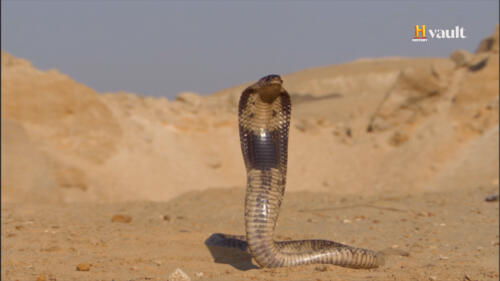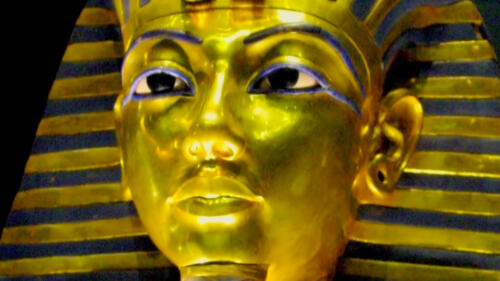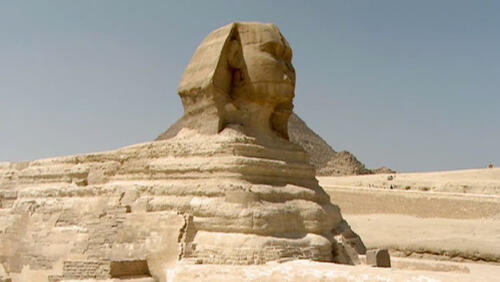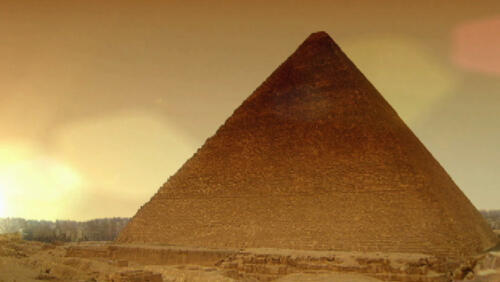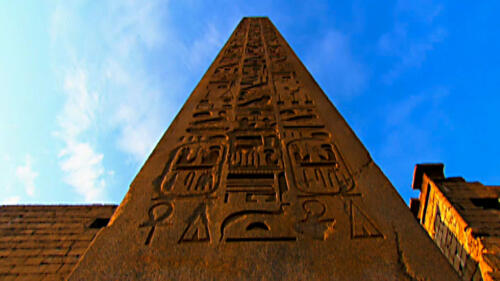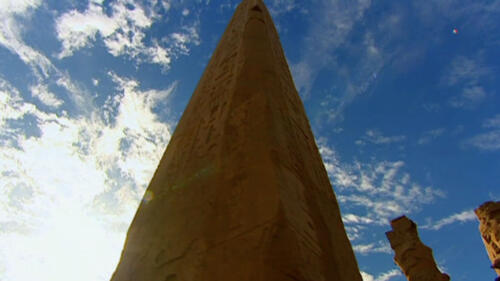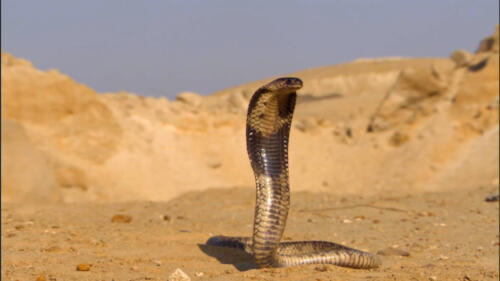Ancient Egypt
Ancient Egypt was home to one of the greatest empires in history, with leaders like Tutankhamen (King Tut), Cleopatra, Ramses II and landmarks like the Great Pyramid at Giza and the Sphinx.
Featured Overview
An ancient pharaoh is credited with the construction of the Abu Rawash and the Great Pyramid - both are considered to be engineering marvels, in this clip.
3:13m watch

Illustration by Eduardo Ramón Trejo. Photos from Getty Images.
Featured Overview
An ancient pharaoh is credited with the construction of the Abu Rawash and the Great Pyramid - both are considered to be engineering marvels, in this clip.
3:13m watch
Start Here

Built during a time when Egypt was one of the richest and most powerful civilizations in the world, the pyramids—especially the Great Pyramids of Giza—are some of the most magnificent man-made structures in history.

The venom of an asp—or even a cobra—supposedly killed the legendary queen of Egypt. Is it true?

A volcanic eruption and shift in climate could have triggered a series of ancient calamities—from pestilence to locusts—as described in the Bible.

A dagger crafted from meteorite and the remains of King Tut's stillborn daughters are among the stunning artifacts found in the tomb.
Cleopatra Becomes Queen of Egypt
Ancient Empires: Cleopatra Becoming a Queen
Following the death of her father, Ptolemy XII Auletes, Cleopatra is crowned Queen of Egypt. Learn more in this exclusive scene from Ancient Empires.
6:02 watch

3 Everyday Objects of Ancient Egypt
Explore All Related Topics

The position of her mouth suggests this ancient Egyptian woman may have died in agony, possibly while screaming either in pain or fear.

History is filled with tortured stories of people drinking gold, transfusing blood and taking potions to defy death.
Ramesses II ran a mighty Egyptian Empire that combined art and engineering, but what led to its fall?
8:22m watch
In the Valley of Kings lay the tombs of many ancient Egyptian pharaohs and powerful nobles.
8:02m watch
Evidence reveals that ancient Egyptians developed advanced weapon-making techniques, making them a force to be reckoned with.
12:23m watch
Take an inside look at the tombs of ancient Egypt, and the chilling message encoded within the walls.
10:58m watch
At one time, ancient Egypt was the most important civilization in the world. Watch as we count down the top 10 entries that have shaped our understanding of ancient Egypt, in this episode of Ancient Top 10.
12:50m watch
Some of the greatest monuments of all time were built 1,000s of years ago. Learn more about the dark secrets behind Egypt's biggest monuments.
6:34m watch
The super ships of the ancient world provided numerous benefits to the Egyptians and created new modes of transportation.
10:48m watch
Experts take a deeper look at the ancient Egyptian civilization, the practice of mummification, and the crocodile god Sebek.
6:51m watch

For millennia, ancient Egyptian doctors were trailblazers—and evidence detected on skulls suggests its doctors may have even attempted to treat cancer.

A volcanic eruption and shift in climate could have triggered a series of ancient calamities—from pestilence to locusts—as described in the Bible.
Archeologist begin searching for Egypt's lost 4th pyramid, in this clip from Season 1, "The Lost Pyramid."
5:46m watch
Following the death of her father, Ptolemy XII Auletes, Cleopatra is crowned Queen of Egypt. Learn more in this exclusive scene from Ancient Empires.
6:02m watch

To consolidate power, the last queen of Egypt married—then killed—her siblings. And she bore children with Roman allies Julius Caesar and Mark Antony.

The artifact, picked up by a retiree walking on a beach in Israel, depicts one of the most powerful deities of ancient Egypt.

A dagger crafted from meteorite and the remains of King Tut's stillborn daughters are among the stunning artifacts found in the tomb.

The once-great empire on the Nile was slowly brought to its knees by a centuries-long drought, economic crises and opportunistic foreign invaders.

Ancient Egyptians left behind a trove of artifacts that shed light on daily life during the civilization's 3000-year existence.
An ancient pharaoh is credited with the construction of the Abu Rawash and the Great Pyramid - both are considered to be engineering marvels, in this clip.
3:13m watch

Felines served a useful purpose in ancient Egyptian households and were eventually associated with deities.

The script found on the insides of ancient Egyptian temples, monuments and tombs represents a complex remnant of history.
Some mysteries we may never find the answer to, but some are begging to be solved! From secret sunken cities to unknown texts, discover the 9 greatest unsolved mysteries of ancient history - in this episode of History Countdown.
9:10m watch
Learn the reason for the death of Cleopatra.
1:38m watch

From axes to swords to chariots, see the weapons that helped make ancient Egyptian warriors formidable.

Dig into the superstitions that surround King Tut’s tomb, the Hope Diamond and more.

The venom of an asp—or even a cobra—supposedly killed the legendary queen of Egypt. Is it true?

From King Tut's tomb to the pyramids, here are the greatest archaeological finds from Egypt.

Decades of research and high-tech forensics have offered multiple theories.

An upgrade of the Boy King's burial chamber took a decade.

Here are the most fascinating finds of the year.

The ancient tombs contained a well-preserved woman and the priest responsible for embalming the pharaohs.

The discovery of a 4,500-year-old ramp offers clues about Egyptians' technological knowledge.

A years-long hunt ended in disappointment—and Nefertiti’s tomb remains elusive.

These razor-sharp blades inspired fear and fascination and helped change the course of military campaigns.

The Great Sphinx of Giza is a 4,500-year-old statue near Egypt's Great Pyramid. At 240 feet long and 66 feet high, it is one of the world's largest monuments.

Unlike Hollywood portrayals with outstretched arms and shuffling feet, mummies are persons or animals whose bodies have been dried or otherwise preserved after death.

From ancient Roman bacchanalia to the Shah of Iran's $175 million birthday party, these are some of history's most epic bashes.

Archaeologists say a pair of dismembered, mummified legs found inside an ancient Egyptian tomb are most likely those of the famed Queen Nefertari, consort of King Ramses II.

Egypt’s oldest papyrus fragments, which detail the construction of the Great Pyramid of Giza, have gone on public display in Cairo.

The iron blade of an ornate dagger buried with Egypt’s King Tutankhamun in the 14th century B.C. likely came from a fallen meteorite, according to a new study.

CT scan images suggest that as one assailant slit Ramses III’s throat, another severed his right big toe.

A British archaeologist believes ancient Egypt’s Queen Nefertiti may be buried behind a secret door inside of King Tut’s tomb.

Check out 10 surprising facts about the fabled Queen of the Nile.

Estimates suggest the project took about two decades to complete.

British scientists have uncovered a secret at the heart of ancient Egypt’s large cache of animal mummies—many of them contain no animal remains at all.

An Italian researcher has concluded that a painting some have called the ancient Egyptian equivalent of DaVinci’s “Mona Lisa” is probably a fake.

The Ancient Egyptian slab helped crack the code of hieroglyphics.

The longest river in the world, measured from its mouth to its most distant, year-round source, is likely the Amazon, which flows 4,345 miles from the Peruvian Andes through Brazil to the Atlantic Ocean. However, much depends on how you measure it. Until 2007, the title belonged to the Nile, which runs 4,258 miles from […]

Six surprising facts about the Egyptian boy king and his final resting place.

Today, mummies are some of the most prized and highly valued artifacts of antiquity, but it might surprise you to know that prior to the 19th century, this wasn’t always the case.

In early 1923, British archaeologist Howard Carter and his financier friend George Herbert, Lord Carnarvon, ceremoniously opened the long-obscured burial chamber of the boy pharaoh Tutankhamen in Egypt’s Valley of the Kings. Two months later, Carnarvon was dead, killed by blood poisoning from an infected mosquito bite on his cheek. Newspapers speculated that he was […]

From the earliest recorded peace treaty to ancient board games, discover 11 surprising facts about the Gift of the Nile.
According to one theory, an accident caused the untimely death of teenage pharaoh King Tut. How might a broken leg have sent him to his tomb?
2:20m watch
The Great Sphinx is an engineering marvel even by today's standards.
1:30m watch
Ancient Egyptians developed a form of aspirin 5,000 years before the advent of modern medicine.
1:07m watch
The Lighthouse at Alexandria was the first known lighthouse and stood for 1600 years on the coast of Egypt.
1:58m watch
Did you know that the Great Pyramid of Giza weighs 6.5 million tons? Get the facts on what makes this ancient wonder a true architectural marvel.
1:31m watch
Ramses built the Temple at Abu Simbel in Egypt to intimidate his enemies and seat himself amongst the gods.
2:42m watch
Workers carved the 700-ton Obelisks of Luxor from a single piece of red granite.
3:14m watch
In this Lost Worlds video, brought to you by the History Channel, learn about man's ability to come up with creative solutions to move stone throughout history. Watch as this video takes us from Egypt to Greece to Jerusalem showing us different solutions throughout history for constructing giant structures like obelisks and temples.
4:31m watch
Legend has it that Cleopatra took her own life by succumbing willingly to the bite of a cobra. If this story is true, was suicide by snake venom an easy way to go, or did the last Egyptian pharaoh die in excruciating pain?
2:34m watch

Queen Nefertiti (1370-c. 1330) ruled Ancient Egypt with her husband Akhenaten (aka Amenhotep IV). She was reknown for her beauty, as depicted by her limestone bust, one of the most recognizable works of Egyptian art.

Hatshepsut oversaw ambitious building projects, including the Temple of Deir el-Bahri, during her reign in 15th century B.C. as a rare Egyptian female pharaoh.

Tutankhamun, or simply King Tut, ruled Egypt as pharaoh until his early death. Howard Carter found his tomb intact, setting off a worldwide Egyptology frenzy.

Cleopatra VII ruled ancient Egypt as co-regent for almost three decades. She is famed for her savvy political alliances with Julius Caesar and Mark Antony.

Famous tombs around the world include the Egyptian tombs, Jesus’ burial ground in Jerusalem, the Prophet’s Mosque and many more.

Built during a time when Egypt was one of the richest and most powerful civilizations in the world, the pyramids—especially the Great Pyramids of Giza—are some of the most magnificent man-made structures in history.

Ancient Egypt was the preeminent civilization in the Mediterranean world from around 3100 B.C. to its conquest in 332 B.C.







